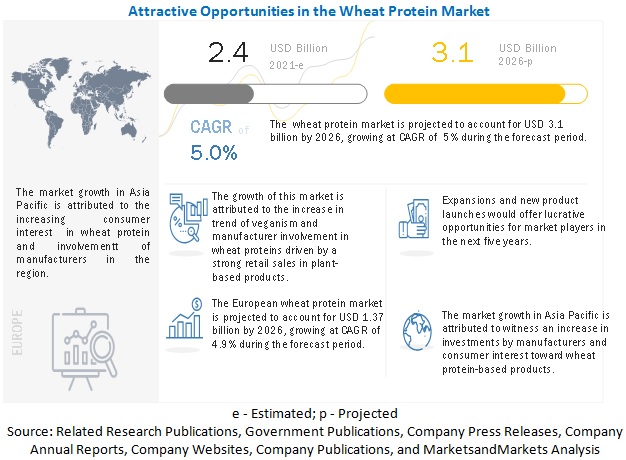The report “Wheat Protein Market by Product (Wheat Gluten, Wheat Protein Isolate, Textured Wheat Protein, Hydrolyzed Wheat Protein), Application (Bakery, Pet Food, Nutritional Bars, Processed Meat, Meat Analogs), Form (Dry, Liquid), and Region – Global Forecast to 2026″, The wheat protein market is projected to reach USD 3.1 billion by 2026, from USD 2.4 billion in 2021, at a CAGR of 5.0% during the forecast period. The market is driven by factors such as a shift in preference for plant-based protein foods, increased demand for meat-free diets, and a growing incidence of lactose intolerance.

COVID-19 impact on Wheat Protein market
The COVID-19 pandemic has had a profound impact on the wheat protein market. Given the growing consumer awareness of the impact of the pandemic on meat production, consumers began adopting plant-based alternatives instead. This resulted in a sales surge of over 500% for meat alternative brands. The pandemic has also influenced the sales of plant-based snacks, dairy alternatives, and supplements, as consumers move towards a healthier lifestyle.
Download PDF Brochure: https://www.marketsandmarkets.com/pdfdownloadNew.asp?id=67845768
Driver: Nutritional benefits for lactose intolerant and health- & fitness-conscious consumers
The Lactose intolerance is defined as a condition whereby, the body cannot easily digest lactose, which is a type of natural sugar found in milk and other dairy products. Although some people having a lactose intolerance issue are able to digest whey protein isolates, without any severe repercussions, others find it easier to digest only plant-based proteins. Although whey protein isolates are further processed and filtered to help eliminate more lactose in comparison to whey protein concentrates, any individual with even a mild intolerance towards lactose should avoid the consumption of these products. In such cases, plant-based alternatives stand as the most suitable option, for those looking to increase protein intake, for health or training purposes. A number of plant-based alternatives, which could be used in place of whey proteins include pea protein isolates, brown rice protein, or wheat protein.
Restraints: Increasing discussion on gluten intolerance and gluten-free diets
Gluten intolerance or the Celiac disease is an autoimmune disorder, which damages the small intestine lining and prevents the absorption of nutrients from consumed food items. This damage is majorly a reaction to eating foods with gluten, a type of wheat protein which is also found in barley, rye, and oats. However, some individuals may also experience discomfort in their stomach despite not having the Celiac disease. Amylase-trypsin-inhibitors or ATIs, are a group of proteins found in wheat, which could trigger an immune response, and contribute to the development of non-celiac gluten sensitivity (NCGS).
Gluten intolerance or the Celiac disease is an autoimmune disorder, which damages the small intestine lining and prevents the absorption of nutrients from consumed food items. This damage is majorly a reaction to eating foods with gluten, a type of wheat protein which is also found in barley, rye, and oats. However, some individuals may also experience discomfort in their stomach despite not having the Celiac disease. Amylase-trypsin-inhibitors or ATIs, are a group of proteins found in wheat, which could trigger an immune response, and contribute to the development of non-celiac gluten sensitivity (NCGS).
Make an Inquiry: https://www.marketsandmarkets.com/Enquiry_Before_BuyingNew.asp?id=67845768
Asia Pacific is projected to. be the fastest-growing region in the wheat protein market during the forecast period.
The Asia Pacific region is projected to be the fastest growing region due to increased demand for meat-free diets and a shift in consumer preference for healthy food options. The increase in R&D for plant-based protein, the growing vegan population, new product launches, and growing investments in the bakery industry are expected to drive the wheat protein market growth in this region during the forecast period.
Key Market Players:
Key players in this market include ADM (US), Cargill (US), Agrana (Austria), MGP Ingredients (US), Manildra Group (Australia), Roquette (France), and Glico Nutrition (Japan). These major players in this market are focusing on increasing their presence through expansions & investments, mergers & acquisitions, partnerships, joint ventures, and agreements. These companies have a strong presence in North America, Asia Pacific, and Europe. They also have manufacturing facilities, along with strong distribution networks across these regions.
Recent Developments:
- In September 2020, ADM launched Prolite MeatTEX textured wheat protein and Prolite MeatXT non-textured wheat protein, which contribute meat-like texture to meat and seafood alternative products. They have a clean taste, a blank-slate color base, and offer enhanced water absorption and hydration speeds.
- In April 2020, MGP Ingredients launched the ProTerra line of textured proteins. ProTerra is especially suited for use in vegetarian/vegan applications as well as in blended products as an extension or partial substitute for meat.
- In November 2019, Agrana opened a new wheat starch processing plant in Austria. The new facility will allow Agrana to double its wheat starch production capacity. Agrana’s expanded wheat starch facility holds the capacity to process around 650,000 tonnes of wheat per annum to produce 50,000 tonnes of wheat gluten.


